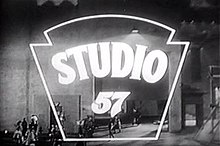Studio 57
| Studio 57 | |
|---|---|
 Title screenshot | |
| Also known as | Heinz Studio 57 |
| Genre | Anthology |
| Directed by | David Butler John Brahm Herschel Daugherty Peter Godfrey Richard Irving Phil Karlson James Neilson Ozzie Nelson Don Weis |
| Presented by | Joel Aldrich |
| Country of origin | United States |
| Original language | English |
| Production | |
| Camera setup | Single-camera |
| Running time | 25 mins. |
| Original release | |
| Network | DuMont (1954–1955) Syndication (1955–1956) |
| Release | September 21, 1954 – 1958 |
Studio 57 (also known as Heinz Studio 57) is an American anthology series that was broadcast on the now-defunct DuMont Television Network from September 1954 to July 1955, and in syndication from 1955 to 1958.
"It's a Small World", the pilot episode of the series Leave It to Beaver, was broadcast on the show on April 23, 1957.[1]
Overview
The program was a filmed anthology television series sponsored by Heinz 57 and produced by Revue Studios. The program aired on the DuMont network from September 21, 1954, to July 26, 1955,[2][3] making it "one of the last regularly-scheduled series ever carried on the crumbling DuMont network".[4] (Only What's the Story and boxing matches aired on DuMont afterwards). Studio 57 aired in first-run syndication from September 1955 to 1958.[3]
The series was exported to Australia during the late 1950s under the title Whitehall Playhouse. Since some of the episodes shown there were DuMont-aired episodes, this makes Studio 57 the only DuMont show to be broadcast outside of North America. The series began airing in Australia in late 1956, during the first few months of television in that country, continuing for several years, and eventually including episodes of other American anthology series such as The Star and the Story.
Cast
The series featured many established actors, including Robert Armstrong,[5] Jean Byron,[6] Lon Chaney Jr.,[7] Andy Clyde,[8] Carolyn Jones,[9] Brian Keith,[10] Charles Coburn,[11] Olive Sturgess,[12] Peter Lawford, Mike Connors, Jane Darwell, Joanne Dru, Peter Graves, Vivi Janiss, Keenan Wynn, Keye Luke, and DeForest Kelley.[13]
Criticism
Television historians Tim Brooks and Earle Marsh describe the scripts for Studio 57 as bland. Ailing DuMont lacked the budgets of CBS or NBC, and hence relied on cost-cutting measures, including hiring then-unknown actors to star in their series such as Hugh O'Brian and Natalie Wood.[4]
See also
- List of programs broadcast by the DuMont Television Network
- List of surviving DuMont Television Network broadcasts
References
- ^ "It's A Small World". incredibletvandmovies.com. Retrieved 21 October 2013.
- ^ Internet Movie Database
- ^ a b McNeil, Alex (1996). Total Television (4th ed.), p. 797. New York: Penguin Books. ISBN 0-14-024916-8
- ^ a b Brooks, Tim; Marsh, Earle (2007). The Complete Directory to Prime Time Network Cable and TV Shows, 1946-Present (9th ed.). New York: Ballantine. p. 1322. ISBN 978-0-345-49773-4.
- ^ "Secret Message" at IMDb
- ^ "The Last Day on Earth" at IMDb
- ^ Lon Chaney Jr. at IMDb
- ^ Andy Clyde at IMDb
- ^ "The Black Sheep's Daughter" at IMDb
- ^ Brian Keith at IMDb
- ^ "Sam" at IMDb
- ^ Olive Sturgess at IMDb
- ^ DeForest Kelley at IMDb
Bibliography
- David Weinstein, The Forgotten Network: DuMont and the Birth of American Television (Philadelphia: Temple University Press, 2004) ISBN 1-59213-245-6
- Alex McNeil, Total Television, Fourth edition (New York: Penguin Books, 1980) ISBN 0-14-024916-8
- Tim Brooks and Earle Marsh, The Complete Directory to Prime Time Network TV Shows, Third edition (New York: Ballantine Books, 1964) ISBN 0-345-31864-1
External links
- Articles sourced by IMDb from September 2019
- 1954 American television series debuts
- 1956 American television series endings
- 1950s American anthology television series
- American drama television series
- Black-and-white American television shows
- DuMont Television Network original programming
- English-language television shows
- First-run syndicated television programs in the United States
- Television series by Universal Television
